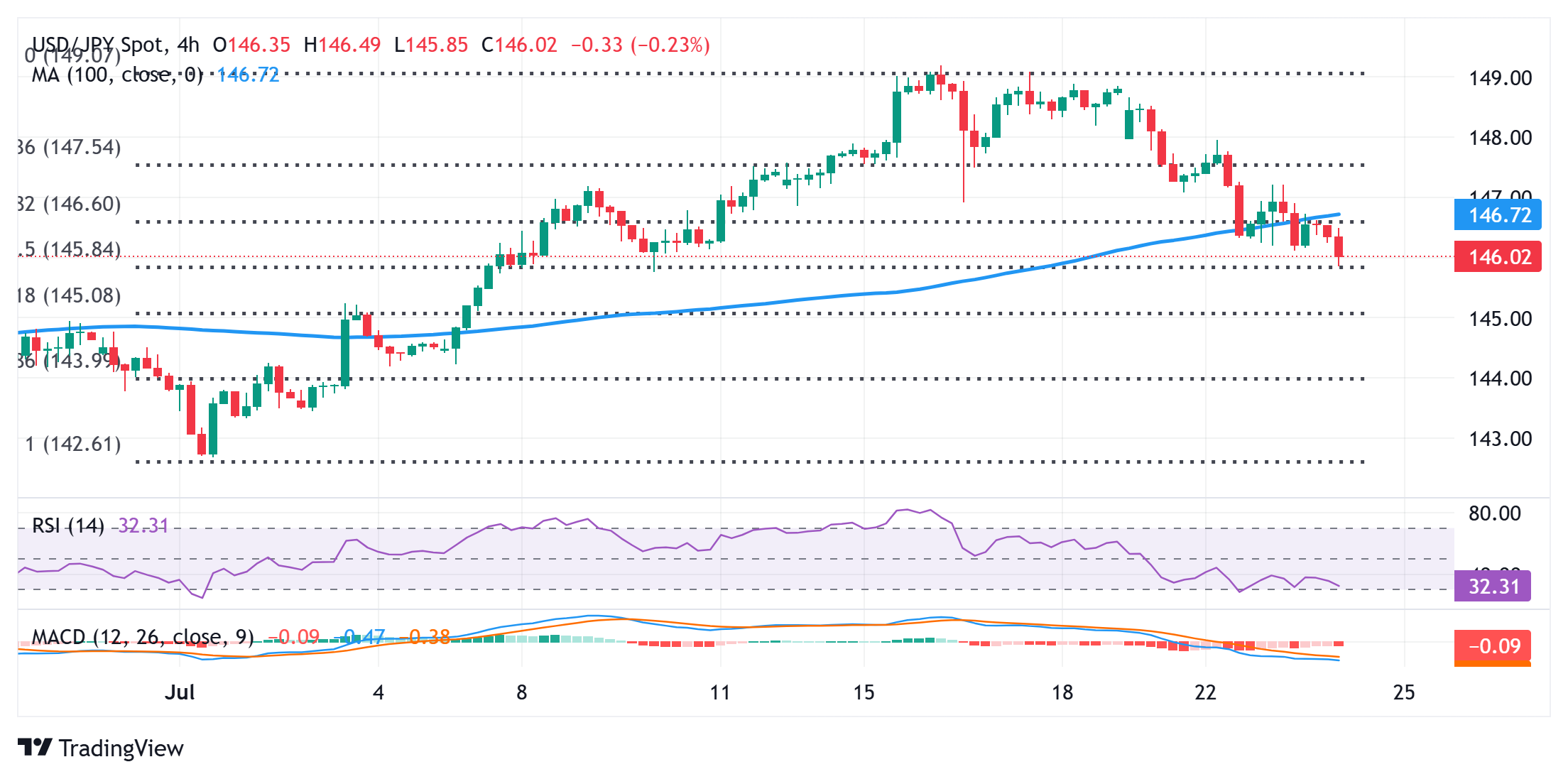Created
: 2025.07.24














![]() 2025.07.24 11:35
2025.07.24 11:35
The Japanese Yen (JPY) strengthens against its American counterpart for the fourth consecutive day and advances to a nearly three-week peak during the Asian session on Thursday. The recently announced Japan-US trade deal reduces economic uncertainty and raises the likelihood that the Bank of Japan (BoJ) will resume its tightening cycle later this year, which, in turn, is seen as a key factor that continues to underpin the JPY. The US Dollar (USD), on the other hand, languishes near a two-and-a-half-week low and exerts additional pressure on the USD/JPY pair.
However, the domestic political uncertainty and the disappointing release of the flash Japan Manufacturing PMI might hold back the JPY bulls from placing aggressive bets. Furthermore, the upbeat market mood should contribute to capping gains for the safe-haven JPY and limiting further losses for the USD/JPY pair. Traders now look forward to the flash US PMIs to grab short-term opportunities later during the North American session. Nevertheless, the mixed fundamental backdrop warrants caution before placing aggressive directional bets.

From a technical perspective, an intraday breakdown below the 100-period Simple Moving Average (SMA) and the 146.00 mark could be seen as a key trigger for the USD/JPY bears. Moreover, oscillators on the daily chart have just started gaining negative traction and back the case for a further depreciating move. Some follow-through selling below the 145.75 area (July 10 low) will reaffirm the outlook and drag spot prices to the 145.20-145.15 region, or the 61.8% Fibonacci retracement level of the upswing in July, en route to the 145.00 psychological mark.
On the flip side, the 100-period SMA support breakpoint, currently pegged near the 146.60 area, which now coincides with the 38.2% Fibo. retracement level, should now act as an immediate strong barrier. A sustained strength beyond could lift the USD/JPY pair to the 147.00 round figure. This is closely followed by the overnight swing high, around the 147.20 area, which, if cleared, could allow spot prices to accelerate the move up towards the 147.60-147.65 intermediate hurdle en route to the 148.00 round figure.
Tariffs are customs duties levied on certain merchandise imports or a category of products. Tariffs are designed to help local producers and manufacturers be more competitive in the market by providing a price advantage over similar goods that can be imported. Tariffs are widely used as tools of protectionism, along with trade barriers and import quotas.
Although tariffs and taxes both generate government revenue to fund public goods and services, they have several distinctions. Tariffs are prepaid at the port of entry, while taxes are paid at the time of purchase. Taxes are imposed on individual taxpayers and businesses, while tariffs are paid by importers.
There are two schools of thought among economists regarding the usage of tariffs. While some argue that tariffs are necessary to protect domestic industries and address trade imbalances, others see them as a harmful tool that could potentially drive prices higher over the long term and lead to a damaging trade war by encouraging tit-for-tat tariffs.
During the run-up to the presidential election in November 2024, Donald Trump made it clear that he intends to use tariffs to support the US economy and American producers. In 2024, Mexico, China and Canada accounted for 42% of total US imports. In this period, Mexico stood out as the top exporter with $466.6 billion, according to the US Census Bureau. Hence, Trump wants to focus on these three nations when imposing tariffs. He also plans to use the revenue generated through tariffs to lower personal income taxes.
![]()
Created
: 2025.07.24
![]()
Last updated
: 2025.07.24

FXStreet is a forex information website, delivering market analysis and news articles 24/7.
It features a number of articles contributed by well-known analysts, in addition to the ones by its editorial team.
Founded in 2000 by Francesc Riverola, a Spanish economist, it has grown to become a world-renowned information website.
We hope you find this article useful. Any comments or suggestions will be greatly appreciated.
We are also looking for writers with extensive experience in forex and crypto to join us.
please contact us at [email protected].
Disclaimer:
All information and content provided on this website is provided for informational purposes only and is not intended to solicit any investment. Although all efforts are made in order to ensure that the information is correct, no guarantee is provided for the accuracy of any content on this website. Any decision made shall be the responsibility of the investor and Myforex does not take any responsibility whatsoever regarding the use of any information provided herein.
The content provided on this website belongs to Myforex and, where stated, the relevant licensors. All rights are reserved by Myforex and the relevant licensors, and no content of this website, whether in full or in part, shall be copied or displayed elsewhere without the explicit written permission of the relevant copyright holder. If you wish to use any part of the content provided on this website, please ensure that you contact Myforex.
Myforex uses cookies to improve the convenience and functionality of this website. This website may include cookies not only by us but also by third parties (advertisers, log analysts, etc.) for the purpose of tracking the activities of users. Cookie policy